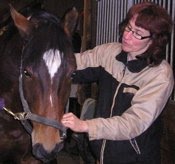And so it is with riding. I consistently find that two things are true when riding.
- Over-thinking gets me into trouble, or at the very least, interferes with the feel that I am striving to develop.
- Sometimes, I have to just go through the motions of grooming, tacking up, and hopping onto my horse, to sort of prime the pump and enable me to have a really good ride.
This is precisely what happened to me yesterday. I had ridden Sid, my really fun, solid, reliable little Standardbred. Good conditioning ride, no expectations of anything else. We had a blast.
Then it was time for me to ride Monarch, my Thoroughbred, who is also a great amount of fun, but let’s just say that he tends to be more “highly aware” than Sid. And once again, right before I got on him, the neighbors across the road decided to try setting off some bottle rockets. Another neighbor was walking down the road with her three unruly dogs and a little kid who was pulling one of those noisy plastic sleds. Oh boy. Combine this with the fact that I hadn’t ridden Monarch in over a week, and my mind was full of the possibilities for things to go wrong. So you see, I was already in defensive mode when I mounted Monarch.
How silly! As it turns out, we had a great ride! I was aware that I was defensive and over-analyzing the situation, and just decided to trust myself and my horse. I worked on getting Monarch’s attention on me, and not on the sled or the dogs, and I did some deep breathing and relaxation exercises for me so that I could be back in my body and less in my mind. You want to lean on my leg, Monarch? I will give you ONE good nudge with my leg to get off me, and that will be that. And I will expect you to respond appropriately. You want to accelerate in the trot and start flying around? Nope. ONE good half-halt will suffice. Then you will resume that nice one-two, one-two cadence. I focused on feeling, and not on thinking. The results were fabulous. Monarch really liked me being clear and not nagging him. He was reaching out for the bit, flicking his ears back and forth, and responding much more willingly and quickly. I really liked being able to communicate with Monarch in a clear, way that left no room for misinterpretation and that relied on feeling rather than thinking.
Here’s wishing you all a wonderful New Year, filled with fun times with your horses!




